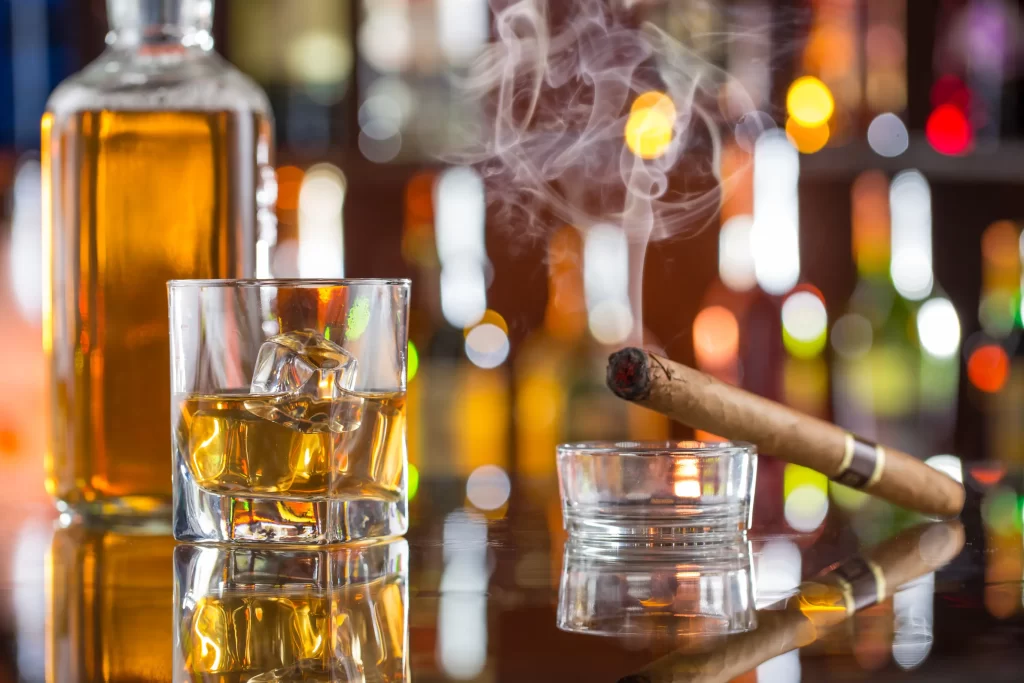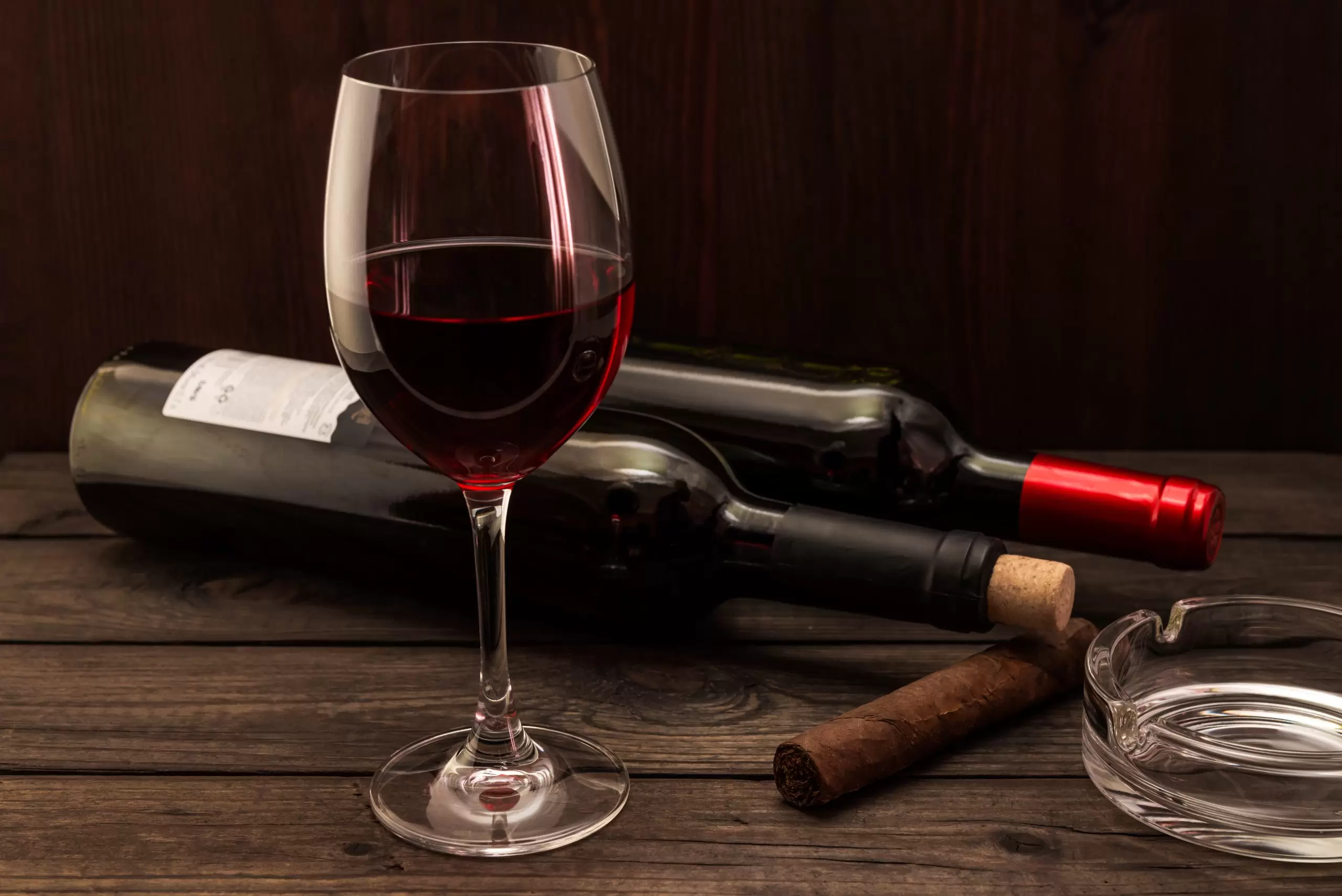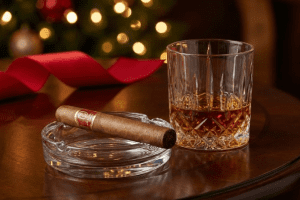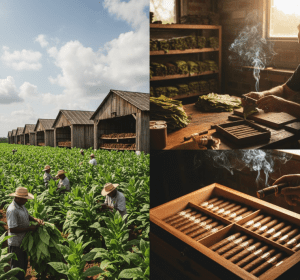Unlocking Flavor: A Guide to the Different Types of Cigars and Their Perfect Pairings
Introduction
Imagine settling into your favorite chair, the rich, inviting aroma of aged tobacco beginning to unfurl. Delving into the world of cigars reveals a fascinating array of options, each promising a unique sensory journey and a moment of cultivated pause. Understanding the different types of cigars available is crucial for appreciating their nuances and selecting one that aligns with your preferences and the moment.
Ready to find your perfect smoke? From invigorating variations in size and shape to the diverse characteristics imparted by different wrapper leaves- like the smooth caress of a Connecticut Shade or the bold statement of a Habano – and the complex symphony of filler tobaccos.
This guide explores the key distinctions among different types of cigars. We’ll culminate in thoughtful suggestions for enhancing your enjoyment through perfect drink pairings, transforming a simple smoke into a memorable experience.
1. Exploring the Different Types of Cigars by Size and Shape (Vitola):
influencing everything from burn time to flavor concentration.
Common vitolas include:
Corona:
A classic size (around 5.5-6 inches) offering a balanced experience, often favored for its consistently smooth draw and even burn.
Robusto:
Shorter and thicker (around 4.75-5.5 inches), this popular choice often delivers a more concentrated, intense flavor profile with a richer, more voluminous smoke.
Churchill:
A longer, stately format (around 7 inches) allowing for a gradual evolution of flavors, perfect for an extended period of thoughtful enjoyment.
Toro:
A popular medium size (around 5.5-6.5 inches) providing an excellent balance of robust flavor, comfortable mouthfeel, and satisfying smoking time.
Panatela:
A long and slender shape (around 6-7.5 inches) known for highlighting focused, nuanced flavors, often with a cooler smoke due to its thinner ring gauge.
Petit Corona:
A smaller version of the Corona (around 4-4.5 inches) ideal for a quicker smoke without sacrificing the character of its larger counterpart.
Figurado Shapes:
Beyond the standard Parejos (straight-sided cigars), Figurados offer visually striking, non-uniform shapes. These include Pyramids (tapering to a pointed head), Belicosos (similar to Pyramids but with a rounded head), Torpedoes (with a sharply pointed head), and Perfectos (bulging in the middle and tapered at both ends).
Each unique form influences the draw and flavor progression, often offering a more dynamic and evolving smoking experience as the burn line travels through the changing shape.
Tip: Choosing Your Vitola: The vitola you choose affects not only the smoking duration but also the perceived intensity and complexity of the tobacco blend.
For instance, a thicker ring gauge can sometimes mean a cooler smoke with a greater volume of flavor, while a longer cigar invites a more leisurely exploration as its taste profile subtly shifts and develops.
2. Discovering the Different Types of Cigars by Wrapper Leaf:
The wrapper leaf is the outermost, visible layer of the cigar and has a profound impact on the cigar’s initial flavor, aroma, and even its feel in your hand. It’s the first impression your palate receives. Some notable wrapper types include:
Connecticut Shade:
Grown under cheesecloth tents to protect it from direct sun, this wrapper is known for its mild, smooth, and creamy flavor, often with delicate notes of cedar, toasted nuts, and a hint of sweetness.
Ecuador Connecticut:
Similar to Connecticut Shade in its mildness but grown in Ecuador’s natural cloud cover, it can offer slightly more body and a more complex flavor profile, sometimes with a whisper of pepper.
Habano:
A robust and often spicy wrapper originating from Cuban-seed tobacco, typically grown in Nicaragua or Ecuador. It delivers earthy – think rich topsoil – and leathery notes, adding a satisfying intensity to the smoke.
Sumatra:
Usually originating from Indonesia or Ecuador, this wrapper is mild to medium-bodied with distinct earthy notes and subtly sweet, sometimes spicy, characteristics.
African Cameroon:
Grown in Central Africa, this thin, toothy wrapper is prized for its smooth, slightly sweet (often described as a rich, dark sweetness), and sometimes spicy character, contributing to a well-balanced flavor.
Maduro:
“Maduro” means “ripe” in Spanish, and these wrappers are distinguished by their dark brown to nearly black color, achieved through extended fermentation. They are known for rich, often sweet notes of dark chocolate, roasted coffee, molasses, and dark fruits.
Oscuro:
Also known as Double Maduro, this is the darkest of all wrappers, often almost black and oily. It’s achieved through even longer and more intense fermentation, delivering bold, complex, and often sweeter flavors, sometimes with a pleasant bitter chocolate or espresso note.
Note: The Wrapper’s Embrace: The selection of the wrapper leaf is a key determinant in the overall taste profile of different types of cigars. Don’t underestimate its influence; this single leaf can contribute up to 60% of the cigar’s initial flavor and sets the stage for the entire experience.
3. Understanding the Different Types of Cigars by Filler Tobacco Origin and Blend:
The filler tobacco, comprising the bulk of the cigar, is often responsible for most of the flavor complexity and the body of the smoke. These carefully selected leaves come from diverse regions, each contributing distinct and sought-after flavors.

Cuban Cigars:
The legendary standard for many, known for their unique complexity and “Cuban twang.” They often feature earthy notes – sometimes reminiscent of a damp forest floor – along with spice (like black pepper), and occasionally floral or honeyed undertones.
Dominican Cigars:
These cigars tend to be smoother and often milder, though many fuller-bodied options exist. Common flavors include cream, nuts (like almonds or cashews), gentle sweetness, and cedar.
Nicaraguan Cigars:
Known for their boldness and often spicy character (think cayenne or white pepper), Nicaraguan cigars are perfect for those who enjoy a more robust and full-flavored smoke. They also frequently offer notes of dark coffee, cocoa, and earth.
Honduran Cigars:
Offering earthy, woody (like oak or cedar), and sometimes spicy flavors, Honduran cigars can range from medium to full-bodied, often providing a rich and satisfying profile.
Blended Cigars:
The art of the master blender truly shines here. Many cigars blend tobaccos from various regions, and even different primings from the same plant, to create a unique, consistent, and often highly complex custom flavor profile that no single origin could achieve alone.
Pro Tip: The Blender’s Craft: The origin and meticulous blending of filler tobaccos are crucial in defining the unique characteristics and the signature experience of different types of cigars. A well-blended cigar tells a story, with flavors that can evolve from start to finish.
4. Enhancing the Experience: Pairing Different Types of Cigars with Drinks:
The enjoyment of a cigar can be significantly enhanced – or sometimes diminished – by pairing it with the right beverage. The goal is to find a companion that complements or offers an interesting contrast to your cigar’s flavors. Here are some general guidelines:
Milder Cigars (e.g., Connecticut Shade, some Dominicans):
If you’re wondering what to pair with a milder cigar for a balanced experience, consider light rums, whose gentle sweetness won’t overpower the cigar’s subtleties. Smooth Irish whiskies, crisp pilsners, or even delicate herbal teas also work beautifully, cleansing the palate and highlighting the cigar’s creamy or nutty notes.
Medium-Bodied Cigars (e.g., Sumatra, Cameroon, many Nicaraguans/Hondurans):
These versatile cigars complement well with medium-bodied rums, bourbons (whose caramel and vanilla notes can marry with the cigar’s complexity), or balanced amber ales. A bolder black tea can also stand up nicely.
Full-Bodied Cigars (e.g., many Habanos, some Nicaraguans, bolder Maduros):
For a truly rich experience with a full-bodied cigar, these are best enjoyed with dark, aged rums, high-proof or peated scotches (where smokiness can meet smokiness), robust strong stouts, or a shot of intense espresso.
Sweet Cigars (Maduros, Oscuros):
If you’re seeking the perfect drink for a sweet Maduro cigar, pair it with equally sweet or complementary drinks like aged rum (which often has notes of molasses and vanilla), rich port wine, or even sweet cocktails that echo the cigar’s dessert-like qualities.
Spicy Cigars (Habanos or some Nicaraguans):
To balance or enhance the spice in these cigars, contrasting drinks like a bold rye whiskey (with its own spicy kick) or ginger-infused beverages work well. A hoppy IPA can also provide an interesting counterpoint.
Tip: Your Palate is King: Experimentation is highly encouraged to discover your personal preferences! While these suggestions provide a great starting point, the best pairing is ultimately the one that brings you the most enjoyment. Don’t be afraid to try unconventional combinations.
5. Other Different Types of Cigars to Consider:
Beyond the main classifications by vitola, wrapper, and filler, other cigar types cater to different needs and preferences:
Machine-Made Cigars:
Generally more affordable and consistent due to their automated production, these are often suitable for a quick, casual smoke.
Hand-Rolled Cigars (“Hecho a Mano”):
Considered premium quality, these cigars are crafted by skilled artisans (torcedores). This meticulous process allows for more complex blends and construction techniques, typically resulting in a more nuanced and evolving smoking experience.
Flavored Cigars (Infused Cigars):
These cigars are infused with various aromas and flavors – such as vanilla, coffee, cherry, or cognac – during or after the curing process. They offer unique and often sweeter smoking experiences, appealing to those who enjoy aromatic profiles.
Cigarillos:
Essentially small, thin cigars, cigarillos are designed for shorter, quicker smokes, often enjoyed when time is limited but a true tobacco experience is still desired.
Frequently Asked Questions (FAQ) About Different Types of Cigars
Q1: What does “vitola” mean for a cigar, and why does it matter?
A: A “vitola” refers to the specific size and shape of a cigar. It’s important because the vitola significantly influences the smoking experience, affecting aspects like the total smoking time, the concentration and intensity of the flavor, and even how the cigar feels in your hand and mouth.
For example, a thicker ring gauge might offer a cooler smoke, while a longer cigar allows for a more gradual development of flavors.
Q2: How important is the wrapper leaf to a cigar’s overall taste?
A: The wrapper leaf is critically important to a cigar’s overall taste and experience. It’s the outermost layer and provides the first impression your palate receives, often contributing significantly (sometimes up to 60%) to the cigar’s initial flavor and aroma.
Different wrappers, like a mild Connecticut Shade or a robust Habano, offer vastly different sensory profiles.
Q3: Are cigars from one country always the same in terms of strength or flavor?
A: Not necessarily. While certain countries are known for general flavor profiles – for instance, Cuban cigars for their complexity or Dominican cigars for a typically smoother, milder character – there’s a wide range of strengths and flavors within each origin.
The specific tobaccos used, the region within the country, and especially the blending process mean that not all cigars from one country will taste identical.
Q4: Can I enjoy a cigar with a non-alcoholic drink?
A: Absolutely! While classic pairings often involve spirits, many non-alcoholic beverages can beautifully complement a cigar. For milder cigars, delicate herbal teas can be a great match.
For medium to full-bodied cigars, a bold black tea or an intense espresso can enhance the smoking experience wonderfully.
Q5: What’s the main difference between a hand-rolled and a machine-made cigar?
A: The main differences lie in craftsmanship, quality, and the resulting smoking experience. Hand-rolled cigars (“Hecho a Mano”) are considered premium quality, crafted by skilled artisans (torcedores), allowing for more complex blends and construction, which typically results in a more nuanced and evolving flavor.
Machine-made cigars are generally more affordable and consistent due to automated production and are often suited for a quick, casual smoke.
Q6: As a beginner, what kind of cigar characteristics should I look for?
A: If you’re new to cigars, it’s often recommended to start with milder flavor profiles to allow your palate to adjust. Consider cigars with wrappers known for smoothness, like a Connecticut Shade, or those from regions like the Dominican Republic that often produce milder cigars.
A smaller vitola, such as a Petit Corona or a Robusto, might also be a good choice for a shorter, more manageable smoking experience.
Conclusion:
The world of cigars is indeed rich with variety, offering a spectrum of flavors, strengths, and experiences that cater to every conceivable preference. From the first glance at its wrapper to the final satisfying draw, each cigar has a story to tell.
By understanding the different types of cigars, including vitolas, wrappers, and fillers, you can make informed decisions for your next smoke. And when paired with the right drink, the experience can reach new heights of enjoyment. Feeling inspired to explore these flavors? Why don’t you try our cigars and discover your own perfect pairing? What characteristics will you look for?


